A few years ago, I was leading marketing on HotPads.com. We were dramatically increasing our content production, but we were still on an old blog platform (TypePad. In 2013.) and our content wasn’t getting traction. In the first month I was there, the blog received ~60 visits. In the last month I was there (18 months later), it received ~60,000.
While we did a lot of things (cranked up content production, actually started doing keyword research to inform content, hired experts to write content), we also moved the site from TypePad to WordPress and moved it from blog.hotpads.com to hotpads.com/blog (and included a redesign for good measure).
Here’s the Google-only organic traffic from that period. The arrow shows where the migration happened:
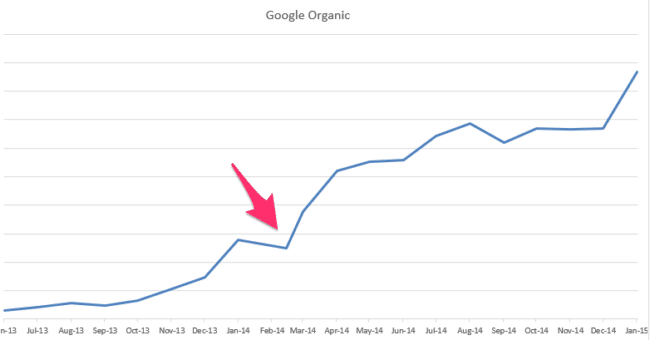
The SEO world loves to debate. If you’ve hung around SEO Twitter for a period of time, you see the same debates over and over, and “subdomain vs subfolder” is one of them.
I’m not interested in debating things where both sides dig in their heels and only offer theoretical or philosophical takes on the debate. I’m interested in what data tells us when websites do things.
By the way, the best piece of content I’ve found on this topic so far and that shows great data in this one by Sistrix. I have also used a few of their examples below.
Table of Contents
No change happens in a vacuum
Nothing happens in a vacuum online (and especially in SEO) for businesses, usually because there are business considerations being taken into account at the same time as SEO changes are being made.
Even if one could test something without changing anything else, the reality is that when you undertake a change you also have to fix other things at the same time because of technical limitations or simply out of respect for your developers to let them do a complete job of something before moving on to the next thing.
It’s a smart investment and use of time to fix multiple things at once, even if that makes correlation/causation difficult to tie back to one specific thing. That said, this doesn’t mean we can’t say anything about the effects of one specific change. We just have to caveat, be more specific, and dig deeper.
Going back to my HotPads example, we didn’t just move from blog.hotpads.com to hotpads.com/blog. We also:
- Changed from TypePad (known for being terrible for SEO) to WordPress (which is infinitely customizable and much easier to optimize);
- Changed from HTTP to HTTPS;
- Implemented properly optimized XML sitemaps;
- Changed internal linking to the blog from the main site (and fixed a nofollow link to the blog from the main site);
- Implemented a custom designed theme;
- Fixed internal linking with Related Posts and new categories (linked to across the blog).
So while I do believe that the subdomain to subfolder change had a massively positive impact on our blog traffic, it would be disingenuous to say that it was the only change made. It would be equally disingenuous to say that it had no impact and all of the other changes were the ones that really had the impact.
What does the SEO world usually say?
It’s honestly not that hard to find a topic like this one that always gets the SEO world up in arms, but this one definitely does.
There are two main camps in the SEO world around subdomains vs subfolders.
The first camp in the that says that moving content from a subdomain to a subfolder/subdirectory always results in an increase in organic traffic.
The other camp says that it doesn’t matter (or maybe more accurately, “it depends”) and you can optimize anything.
Neither side is being naive and neither side is trying to be misleading, as there are great arguments to support each side.
The goal of this article is to show you examples on both sides and help you think through whether you should use a subdomain or subfolder.
Examples of subdomain > subfolder moves
There are many examples out there of moving content from a subdomain to a subfolder and seeing big results.
Monster.co.uk
This first example comes from the Sistrix post linked above, where Monster.co.uk moved their jobs section from jobs.monster.co.uk to monster.co.uk/jobs. Here is SEMrush visibility data for google.co.uk showing the shift:

Moz beginner’s guide to SEO
In March 2014 Moz moved their Beginner’s Guide to SEO from a subdomain (guides.moz.com) to their main domain (moz.com/beginners-guide-to-seo), though interestingly not a true subfolder (eg moz.com/guides/beginners-guide-to-seo).
This is what Rand Fishkin (at the time CEO of Moz) had to say at the time:
In 2014, Moz moved our Beginner’s Guide to SEO from guides.moz.com to moz.com itself. Rankings rose immediately, with no other changes. We ranked higher not only for “seo guide” (outranking Google themselves) but also for “beginners guide” a very broad phrase.
Unfortunately none of the tools I use (SEMrush, Ahrefs, even Moz) do not have the historical data as far back as 2013/2014 for guides.seomoz.org (their old domain) or guides.moz.com, so I cannot corroborate this. But I believe Rand.
Subdomain > changes that went badly
Of course, people like talking about the good things that they did and don’t like to talk about the things they did that did not work.
Therefore, it is MUCH harder to find instances of moving from a subdomain to a subfolder that did not go well.
The only real example I have been able to find is when Pinterest moved content from subdomains to country-specific domains.
Here is an example of their Germany visibility when they moved content from de.pinterest.com to pinterest.de. As you can see, organic traffic actually popped in Germany in December 2016 (my guess is they implemented HREFLANG here) and not in the move to the country-specific domain, though organic growth did continue for a number of months after that change. There was also a bit of a dip back to January-March levels for the months of May/June/July until a pop was seen in August:
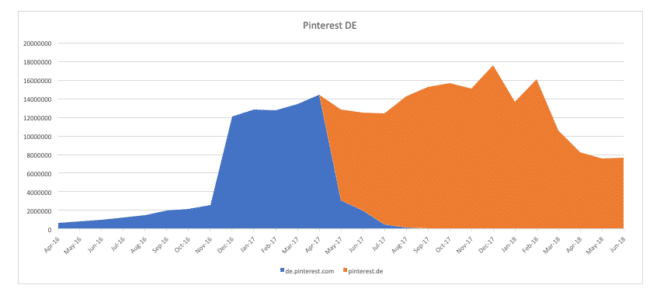
So while it’s not a true subdomain > subfolder move, it is a move off a subdomain to something else that should show an improvement and yet one was not seen for a bit (and then it appears something else changed in January 2018 to negatively affect SEO traffic in Germany).
Examples of subfolder > subdomain moves
There are fewer public instances of sites moving content from a subfolder to a subdomain, but there are a few we can look at.
Iwantmyname.com
This is an interesting case study because they moved their blog from a subfolder to a subdomain, and then back again when traffic tanked.
Here is their SEMrush visibility:
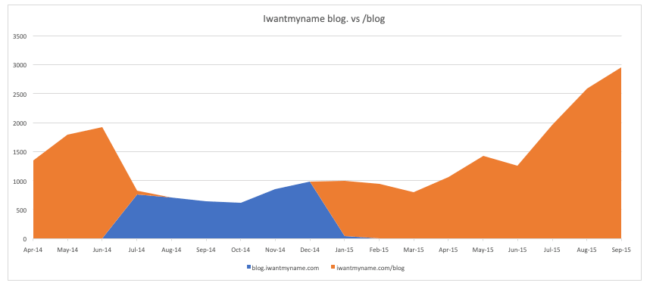
Their traffic was going up, then tanked in the move, then stayed relatively steady on the switch back to the subfolder and then started to go up. This is probably explained by Google being a bit confused about all the moving and it took them time to shake back out the rankings.
It’s not a conclusive study, but it’s interesting.
Law site
There is a law site (that we are unable to share publicly) sent to us by a Credo agency that moved some content from a subfolder to a subdomain and saw traffic increases.
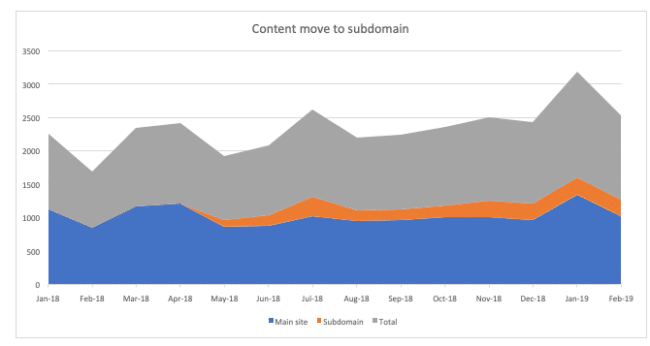
In this case, they moved content specifically meant to target topics at the top of the funnel (and not directly related to their law niche) to an educational subdomain. Traffic did not go down with the move and has even grown, and especially saw the most growth in the couple of months following the split.
Once again, not definitive and there are other things at play (links/no links, technical, etc) but it’s an interesting data point.
Stadtbranchenbuch
This is an example directly from the Sistrix study, a site called Stadtbranchenbuch is Germany. They moved their Berlin section to a subdomain and saw organic visibility growth!
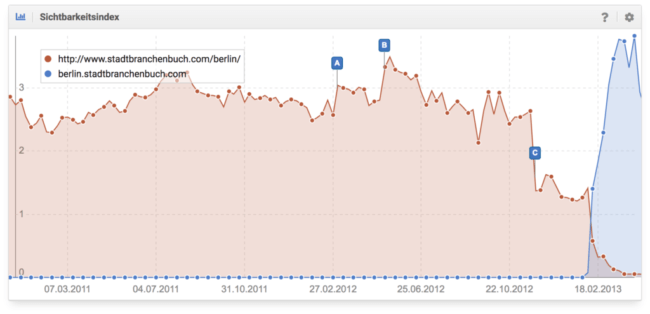
We should definitely note here that this change occurred in early 2013, but it looks like the site was affected by an October 2012 Panda algorithm change that affected ~2.4% of all queries (according to Matt Cutts, former Google Head of Webspam, as reported by SERoundtable).
Moving content from a subfolder to a topic-silo’d subdomain seemed to work for some sites in the days of specific Panda (Google’s low quality content algorithm) updates. Panda is now rolled into the main algorithm, which makes untangling Panda issues harder than in past years.
So, is a subdomain or subfolder better for SEO?
Now that we’ve seen examples on both sides of the equation, what are we left with?
What to remember when making decisions about URLs
As many have said, there is intrinsically not much different between a subdomain and a subfolder. Except, there is. Or, there could be.
Wait, what?
That’s right, the rules are not such. Rules in this area are more guidelines and vary according to the kind of site.
When you’re trying to decide whether to use a subfolder or a subdomain, you need to ask yourself the following questions:
- Do you have the resources to technically optimize two (or more) sites equally? If so, then a subdomain is on the table for you.
- Do you have the resources to build links to both (or more) subdomains, as required to rank them? If so, then a subdomain is on the table for you.
- Is the content that will live on the subdomain topically different from the rest of your site? Then a subdomain may be the right choice.
- Are you bolting a new section onto your site that has to be on a separate CMS and technology stack? A subdomain may be the only choice here because of technical requirements and thus you are stuck optimizing it even if you think the content should be in a subdirectory/subfolder.
When to use a subfolder
It is my opinion that most user-facing (and desiring to rank) content on most websites should be within subfolders. Most sites are not large enough to merit a subdomain for anything except for the four reasons above and especially number 4 above with technical limitations.
While there are a lot of sites currently on the web that have an old CMS for their “marketing site” and a different CMS for their blog or content section, the reality is that pretty much every CMS for smaller businesses these days has both transactional page and content page capabilities.
A lot of these sites would be wise in my opinion to redo their websites to a more modern framework that loads faster and provides a better user experience. One likely positive side effect of this would be the ability to move content to the main domain.
So, in my opinion the question is not “when should I use a subfolder”. Using subfolders is the default in my opinion.
The question should rather be “when should I use a subdomain and leverage its advantages instead of using a subfolder/subdirectory on my main site?”
(Remember, www is itself a subdomain. Mind=blown.)
When to use a subdomain
There are absolutely legitimate times to use a subdomain and there are definitely companies using them to great effect.
A subdomain is the right choice if:
- The content is substantially different topically from the rest of your site and thus would be confusing to users to have it on the main domain;
- You have the internal capabilities to upkeep and optimize the site as well as the monetary resources to build links for SEO to help it rank;
- You have technical limitations that cannot be overcome and thus a subdomain is the only choice.
If you’re relegated to using a subdomain, or if a subdomain makes the most sense, you can’t treat it the same as a subfolder because it quite simply does not inherit, in the same way, the authority of the www/main part of the site. You’ll need to make sure you’re building links to it, are linking to it from your main site (if and where it makes sense), and treating it as its own site with its own Search Console, Google Analytics, and budget to make it rank.
Your work will be, in my experience, harder to rank the subdomain but it is still absolutely possible.
I hope by now you see that there is no clearcut answer to “subdomain or subdirectory/subfolder”, but there are guidelines we can use and questions we can ask ourselves to determine the right direction.
What do you think? How is your thinking about this conundrum different from mine?
Sound off in the comments (be nice, please).

